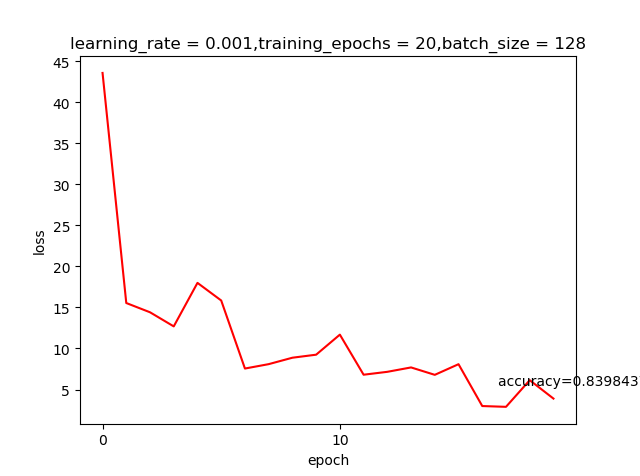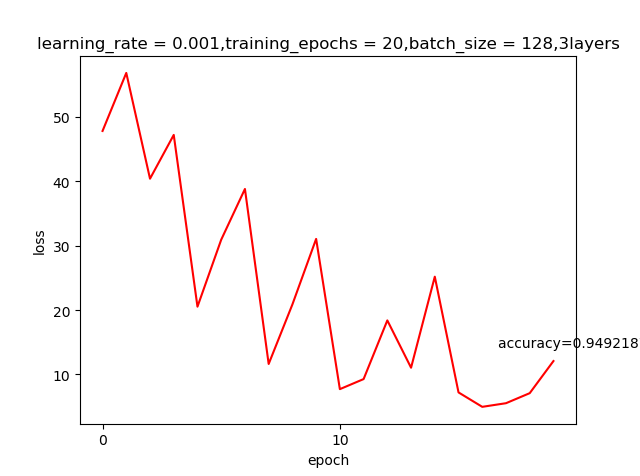04-02 Deep_Neural_Network–在TensorFlow保存与加载model
我们在上节课的训练中发现,每个回合训练的时间很久,加大训练回合之后所用的训练时间就更长了。一旦我们的程序结束,再次运行时原有的weight和bias信息全部消失了,又要重新训练。TensorFlow中设置了保存与加载的机制来解决这个问题。同时我们上节课建立的神经网络还不够“深”,只有一个隐藏层,这节课我们来加深神经网络。
加深神经网络
上节课我们一开始使用epoch=20,learning rate=0.001,训练结束后的精度accuracy=0.839

我们只用了一层ReLU,如果我们加大神经网络的复杂度,再增加一层ReLU,那这个精度表现会不会有改变呢?试试就知道了
# 权重和偏置需要有两份,一份是wx+b;另一份是w1*ReLU输出+b1
weights = {
'hidden_layer': tf.Variable(tf.random_normal([n_input, n_hidden_layer])),
'hidden_layer2': tf.Variable(tf.random_normal([n_hidden_layer, n_hidden_layer])),
'out': tf.Variable(tf.random_normal([n_hidden_layer, n_classes]))
}
biases = {
'hidden_layer': tf.Variable(tf.random_normal([n_hidden_layer])),
'hidden_layer2': tf.Variable(tf.random_normal([n_hidden_layer])),
'out': tf.Variable(tf.random_normal([n_classes]))
}
这里面我们增加了一层hidden_layer2,系统示意图如下:
这样我们就建立了3层的神经网络。运行一次训练会发现accuracy直接提升到了0.92以上,证明增加网络层数对提升精度,解决复杂问题是非常有利的。

我们可以看到在3层神经网络训练过程中cost的波动远大于2层神经网络,但是最终的accuracy却高了很多,这是一个有趣的现象,大家可以自由调节参数看看是什么原因导致的。
保存神经网络
TensorFlow中保存的机制是tf.train.Saver.save() 方法,这个方法会将模型中的weight和bias全部保存下来,并且可以保存模型结构。
save_file = './train_model.ckpt'
saver = tf.train.Saver()
<----------训练过程------------->
saver.save(sess, save_file)
print('Trained Model Saved.')
输出结果:
Epoch: 0001 cost= 118.16108703
Epoch: 0002 cost= 35.628852844
Epoch: 0003 cost= 33.554569244
Epoch: 0004 cost= 25.575164795
Epoch: 0005 cost= 16.287216187
Epoch: 0006 cost= 33.322113037
Epoch: 0007 cost= 27.648113251
Epoch: 0008 cost= 41.859161377
Epoch: 0009 cost= 10.666368484
Epoch: 0010 cost= 22.679353714
Epoch: 0011 cost= 13.955465317
Epoch: 0012 cost= 27.295814514
Epoch: 0013 cost= 8.500268936
Epoch: 0014 cost= 28.089063644
Epoch: 0015 cost= 9.669015884
Epoch: 0016 cost= 8.695211411
Epoch: 0017 cost= 6.443881512
Epoch: 0018 cost= 4.647359371
Epoch: 0019 cost= 15.570621490
Epoch: 0020 cost= 8.495063782
Optimization Finished!
Accuracy: 0.9296875
Trained Model Saved.
在当前目录下会出现4个文件:

加载已训练的神经网络
加载的过程也比较简单,使用tf.train.Saver.restore()即可
saver.restore(sess, save_file)
# Test model
correct_prediction = tf.equal(tf.argmax(logits, 1),tf.argmax(y, 1))
# Calculate accuracy
accuracy = tf.reduce_mean(tf.cast(correct_prediction, "float"))
test_accuracy = sess.run(accuracy,feed_dict={x: mnist.test.images, y: mnist.test.labels})
print('Test Accuracy: {}'.format(test_accuracy))
print("Model loaded!")
测试结果:
Test Accuracy: 0.9185000061988831
Model loaded!
这样我们就完成了模型的保存与加载,非常方便。

发表评论
Want to join the discussion?Feel free to contribute!